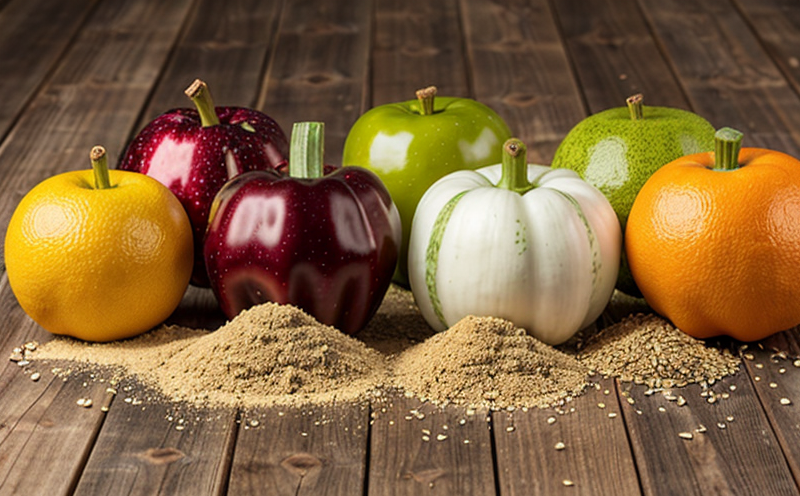EN ISO 21527-1 Yeasts and Moulds Enumeration in Fruit Products
The EN ISO 21527-1 standard specifies methods for the enumeration of yeasts and moulds in fruit products. This method is crucial for ensuring food safety, quality control, and compliance with international standards. Yeasts and moulds can significantly impact the shelf life, sensory characteristics, and microbial safety of fruit products. This service ensures that producers meet these stringent requirements.
Our laboratory adheres strictly to this standard to provide reliable and accurate results. The procedure involves a series of steps, including sample preparation, inoculation, incubation, and counting of colonies on selective media. Each step is critical for obtaining precise enumeration of yeasts and moulds in fruit products.
The process begins with the collection of samples from various sources such as fresh fruits, processed fruit products, or storage facilities. Once collected, these samples undergo thorough preparation to ensure that they are representative of the product being tested. This might include homogenization, dilution, or other treatments depending on the nature and composition of the sample.
The inoculation process is performed using appropriate techniques to introduce a known volume of the prepared sample onto pre-inoculated agar plates containing selective media for yeasts and moulds. Incubation follows under controlled conditions that favor the growth of these microorganisms, typically at 20-25°C for 48 hours.
The final step involves counting the colonies formed on the agar plates using standardized techniques. This enumeration provides an accurate representation of the yeast and mold population present in the fruit product. The results are then reported according to international standards, including any necessary adjustments or corrections made during the process.
Compliance with EN ISO 21527-1 is essential for maintaining high quality and safety standards in the production and distribution of fruit products. By adhering strictly to this standard, we ensure that our clients' products meet all regulatory requirements and consumer expectations.
| Sample Type | Preparation Method | Inoculation Technique | Incubation Conditions | Enumeration Criteria |
|---|---|---|---|---|
| Fruit Juice Concentrate | Dilution, Homogenization | Pipetting onto Agar Plates | 20-25°C for 48 hours | Counting of Colonies on Yeast and Mould Media |
| Fresh Fruit | Cut into Small Pieces, Homogenization | Inoculation with a Known Volume | 20-25°C for 48 hours | Counting of Colonies on Yeast and Mould Media |
| Processed Fruit Products | Dilution, Homogenization | Inoculation with a Known Volume | 20-25°C for 48 hours | Counting of Colonies on Yeast and Mould Media |
This method ensures that the enumeration process is consistent, reproducible, and reliable. It also helps identify potential issues early in the production cycle, allowing for corrective actions to be taken promptly.
Understanding the significance of this testing protocol allows us to offer accurate and precise data on yeast and mold populations. This knowledge can inform decision-making processes related to product development, quality assurance, and regulatory compliance.
Benefits
- Ensures food safety by identifying potential hazards early in the production cycle.
- Enhances product quality through consistent monitoring of yeast and mold levels.
- Facilitates compliance with international standards such as EN ISO 21527-1.
- Provides accurate data for regulatory reporting and documentation.
- Aids in process optimization by identifying areas where improvements can be made.
- Supports product differentiation strategies based on superior quality.
The benefits of adhering to this standard extend beyond mere compliance; they contribute significantly to the overall success of fruit product manufacturers. By implementing rigorous testing procedures, companies can build trust with consumers and maintain a competitive edge in the marketplace.
Industry Applications
| Industry Segment | Description | Application Example |
|---|---|---|
| Fruit Juice Manufacturing | Ensuring safe and high-quality fruit juice products. | Detecting mold contamination in concentrate batches before bottling. |
| Fresh Fruit Packaging | Maintaining hygiene standards during transportation and storage. | Monitoring yeast growth on stored apples to prevent spoilage. |
| Canned Fruit Production | Avoiding product recalls due to microbial contamination. | Counting yeasts and molds in canned peaches before release to market. |
| Juice Blending Companies | Guaranteeing consistent flavor profiles across different batches. | Testing blended fruit juices for mold content after blending. |
The application of this standard in various sectors underscores its importance across the entire fruit product supply chain. Whether it's during production, storage, or final packaging, accurate enumeration of yeasts and molds is critical to maintaining food safety and quality standards.
Environmental and Sustainability Contributions
- Promotes resource efficiency by minimizing waste through early detection of spoilage.
- Saves energy and water resources by preventing overproduction or processing.
- Reduces the carbon footprint associated with transporting unsafe or spoiled products.
- Encourages sustainable practices within the industry through adherence to international standards.
- Supports long-term economic stability for producers who adhere strictly to quality control measures.
The use of EN ISO 21527-1 contributes positively to environmental sustainability by ensuring that only safe and high-quality fruit products reach consumers. This, in turn, reduces the likelihood of consumer complaints or returns, thereby enhancing brand reputation and customer satisfaction.





